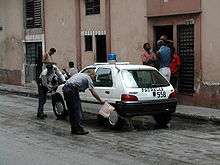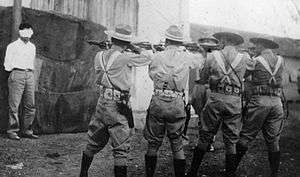Crime in Cuba

Crime is present in various forms in Cuba though the government does not release official crime statistics.[1] Crime reports are on the rise, with below-average crisis intervention from police.[2] Gun crime is virtually nonexistent and murder rates are below those of most Latin American countries. Drug trafficking grew dramatically in the mid-1980s and 1990s. In the 1990s over 200 foreigners and many more Cubans were caught smuggling drugs, and some 31 tons of drugs, mostly United States-bound, were seized by the authorities. Prostitution and pornography are both illegal in Cuba.
History
- 19th century
Some of the laws, crimes, and punishments pertinent to Cuba were enumerated in an 1879 translation of an 1870s document, issued by Spain. The penalties for crimes were subclassified as corporal penalties (including execution by the garrote upon a scaffold), correctional penalties, light penalties, penalties common to the three preceding classes, and accessory penalties. Many crimes were described in the document, under various Titles and Articles:[3]
- Crimes against the external security of the State (such as treason)
- Crimes against the constitution (such as Lèse-majesté)
- Crimes against public order (such as rebellion and sedition)
- Falsitites and falsifications (such as counterfeiting of money or documents)
- Violation of laws relating to interments, violation of sepulchers and offenses against the public health (such as adulterated medicines)
- Gambling and raffles (such as unauthorized lotteries)
- Offenses committed by public employees in the discharge of their office (such as bribery)
- Crimes against persons (such as dueling)
- Crimes against chastity (such as rape)
- Crimes against honor (such as calumny)
- Crimes against the civil status of persons (such as celebration of illegal marriages)
- Crimes against liberty and security (such as abduction of infants or abandonment of children)
- Crimes against property (such as robbery)
- Reckless negligence
- 20th century
Before 1959, crime was quite common with gun wielding criminals holding sway. This necessitated intervention by the then president to hold parleys with them and induct them into the Cuban police force. After some time, the criminal gangs from the US migrated to Cuba and took control of the Casinos. However, as the US government wanted to have a hold on Cuba, they created a security force, a secret service agency which brought crime under control. However, when Cuba planned attack on USA, the situation changed and the police force ensured that the criminal elements were controlled in the country and many of them fled to the US as the immigration rules facilitated such migration.[4]
Drug trafficking grew dramatically in the mid-1980s and 1990s. In the 1990s over 200 foreigners and many more Cubans were caught smuggling drugs, and some 31 tons of drugs, mostly United States-bound, were seized by the authorities.[5] The activity created a climate of fear of mistrust in Cuba, known as "desconfianza".[6] To put an end to the activities of the drug smuggling criminal elements, Cuba established the Committees for the Defense of the Revolution (CDR) throughout the country which was more of a spying force, without camera surveillance, on its citizens operating in each block of every city and suburb in the country. This created a kind of fear psychosis, as the CDR would question any activity of individuals that they suspected could create some criminal activity. They arrested the criminals and jailed them. This also acted a deterrent for people from holding "guns, gang members, drug dealers or gangs of teenaged robbers in Cuba".[4] purposes. Both the American and Cuban governments targeted issues such as migration, drug trafficking, and terrorism.[7]
In the 1990s, a new form of Cuban literature, known as "Cuban Dirty Realism" by critics became popular, reflecting the "prisoners, prostitutes, drug users, alcoholics, thieves, and murderers whose lives involve lots of sex, drinking, drugs" in Cuba.[8] Prostitution grew dramatically during this period, fueled by the increase in tourism in the country and legalization of dollars in 1992. Prostitution isn't illegal in Cuba, but is frowned on by many and is morally reprehensible and considered to be a "social disease" and a "product of pre-revolutionary society's selfish capitalist culture."[9][10] The authorities in Cuba have organized various campaigns against it since the early Castro days, attempting to encourage women to seek more formal employment in factories and gain skills such as sewing.[10] During the 1998 campaign, Cuban police patrolled areas such as Varadero Beach and the Cuban Keys, key tourist areas affected by it.[9] According to reports though, prostitutes often offer bribes to enforcement officers.[9]
Corruption
Cuba has a moderate corruption rate. The 2012 Transparency International Corruption Perceptions Index ranked the country 58th out of 176 countries, tied with Jordan and Namibia. Cuba fared better than most of the other countries in the Caribbean and Central America.[11] State ownership has contributed to rampant corruption. The book Corruption in Cuba says that "As in other former socialist countries, when given opportunity, few citizens hesitate to steal from the government. Since the bulk of the productive resources are owned and managed by the state and the vast majority of Cubans work for state-owned enterprises, these petty crimes are widespread".[12] Bribery is widespread, even in medical care. Musicians regularly pay bribes to perform in tourist areas, where they can earn convertible currency. A bicycle taxi license is reported to cost $150 in bribes.[13] The government has made an effort to curb corruption, and a handful of corrupt individuals have been captured in recent years.[14][15]
Penal codes
In criminal matters, the Penal Code has been in force in Cuba since 1879. The Law of Criminal Procedure has been in force since 1889. In 1900, correctional courts were created for minor offenses and crimes, which were previously sent to various Audiencias for consideration. Penalties included corporal and correctional. The death penalty at the time was described as:[16]
"The penalty of death is executed by means of the instrument known as the "garrote." The execution takes place upon a board platform within the walls of the jail, in the day time, within twenty-four hours after notice of the sentence is given; it is held privately and in the presence of those persons who are required to be present and those who are authorized to witness it by the president of the court. The body of the felon remains exposed upon the gallows for four hours, and is then handed over to his relatives for burial, if they request it, and the burial must take place without any pomp. The death penalty will not be executed upon a woman who is pregnant, and she will not be notified of her sentence until forty days have elapsed after her delivery."
In 1889, the military governor of Cuba revoked some of the provisions of the Penal Code of Spain which had applied to Cuba. Some of the changes included that anyone who promotes or take part in any game of chance, except purely for recreation or pastime, shall be subject to a fine; and that anyone who bribes a public officer with gifts, presents, offerings, or promises shall receive the same punishment as the officer bribed, except the deprivation of office.[17]

- 20th century
In 1926, Fernando Ortiz was entrusted with leading a legal commission to replace the penal code from the time of Spanish regime era. Modeled after Cesare Lombroso's work, Ortiz's had a nationalistic mission in which he developed a "scientific crusade against crime", emphasizing social rehabilitation instead of state retribution.[18]
The country faced radical change of its criminal law structure after 1959. Many common crimes were reclassified as political crimes. The death penalty was reinstated, and a new criminal offense, illicit enrichment, was created. The age of criminal responsibility was placed at sixteen years. In 1979, a new criminal code replaced the one created in 1936 and known as the Social Defense Code. It addressed several areas of crime, such as crime against: state security, administration of justice, public safety, public order, national economy, cultural patrimony, public trust, another person's life and health, individual rights, worker's rights, personal and family relations, minors and youth, and honor.[19] Various articles of the Cuban Penal Code, which appear contrary to democratic principles, are nonetheless codified in the country's socialist laws; these include disrespect, illicit association, enemy propaganda, associating with others to commit crimes, dissemination of false information against international peace, resistance or disobedience, and social dangerousness.[20]
References
- ↑ McAuslan, Fiona; Norman, Matthew (1 September 2010). The Rough Guide to Cuba. Rough Guides. pp. 144–. ISBN 978-1-4053-8778-1.
- ↑ BDS (March 21, 2012). "Cuba 2012 Crime and Safety Report". Report Details. U.S. Department of State, Bureau of Diplomatic Security. Retrieved June 12, 2013.
- ↑ Cuba (1900). Translation of the Penal Code in Force in Cuba and Porto Rico: 1879. U.S. Government Printing Office. p. 31.
- 1 2 "The Safe Streets of Cuba". Havana Times. 8 June 2012. Retrieved 20 June 2013.
- ↑ Pérez-Stable, Marifeli (14 December 2010). The United States and Cuba: Intimate Enemies. Routledge. p. 66. ISBN 978-0-203-87448-6. Retrieved 21 June 2013.
- ↑ Cislo, Andrew M. (2007). Psychological Distress Among Cuban and Colombian Immigrants in Miami: Considering the Roles of Acculturation and Ethnic Discrimination. ProQuest. p. 61. ISBN 978-0-549-46960-5. Retrieved 21 June 2013.
- ↑ Brenner, Philip (2008). A Contemporary Cuba Reader: Reinventing the Revolution. Rowman & Littlefield. p. 209. ISBN 978-0-7425-5507-5. Retrieved 21 June 2013.
- ↑ Hamilton, Carrie (12 March 2012). Sexual Revolutions in Cuba: Passion, Politics, and Memory. UNC Press Books. p. 433. ISBN 978-0-8078-8251-1. Retrieved 21 June 2013.
- 1 2 3 Hudson, Rex A. Cuba: a country study. Government Printing Office, Library of Congress. Federal Research Division. p. 345. ISBN 978-0-8444-1045-6. Retrieved 21 June 2013.
- 1 2 Bunck, Julie Marie (January 1994). Fidel Castro and the Quest for a Revolutionary Culture in Cuba. Penn State Press. p. 96. ISBN 978-0-271-04027-1. Retrieved 21 June 2013.
- ↑ "Transparency International - the global coalition against corruption". Transparency International. 2012. Retrieved 24 March 2012.
- ↑ Díaz-Briquets, Sergio; Pérez-López, Jorge F. Corruption in Cuba. pp. 18, 136.
- ↑ "Cuba's economy rife with corruption". St. Petersburg Times. January 15, 2007.
- ↑ "Cuba jails 12 ex-officials in corruption case". BBC News. August 21, 2012.
- ↑ "The cleanup continues". The Economist. May 6, 2011.
- ↑ Cuba. Ofcina del censo (1907). Cuba: population, history and resources 1907 (Public domain ed.). United States bureau of the census. pp. 113–.
- ↑ Translation of the penal code in force in Cuba and Porto Rico (Public domain ed.). Government Printing Office. 1900. p. 139.
- ↑ Amador, Jose G. (2008). "Redeeming the Tropics": Public Health and National Identity in Cuba, Puerto Rico, and Brazil, 1890--1940. ProQuest. pp. 100–. ISBN 978-0-549-81800-7.
- ↑ Pérez López, Jorge F. (January 1995). Cuba's Second Economy: From Behind the Scenes to Center Stage. Transaction Publishers. pp. 62–. ISBN 978-1-4128-2092-9.
- ↑ José Azel (February 2010). Manana in Cuba: The Legacy of Castroism and Transitional Challenges for Cuba. AuthorHouse. pp. 10–. ISBN 978-1-4490-7656-6.
